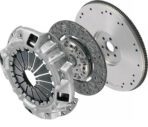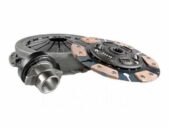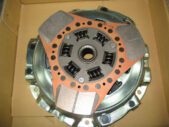
Clutch - strengthening, tuning, ceramic or carbon
Content
Let's say you got a good increase in power, but you can't realize it, because your engine simply turns the clutch into a cloud of steam, erasing into smoke not only the friction linings, but also the basket and the flywheel, absolutely not transferring the engine power to the wheels.
The fact is, the greater the moment that needs to be transferred to the wheels, the greater the load on the clutch, namely on the disc, in the clutch mechanism. With increasing moment, the force of pressing the disk to the flywheel should increase, in addition, you can increase the number of disks. As always, two questions arise: what to do in this situation? The answer is simple - you need to tune the clutch (strengthen).

Clutch mechanism
In the stock version, the clutch mechanism uses organic - a friction material used in 95% of clutches. Its advantages are low cost, soft inclusion, but at the same time reliability and wear resistance are sacrificed.
What are the clutch tuning options?
- ceramics;
- carbon fiber;
- kevlar;
- ceramic with an admixture of copper.
The next question is what to choose? What is better in terms of price / quality ratio, and will allow the wheelbarrow to tumble over an adult, transferring all the moment from the motor to the wheels?
Let's say you decide to put a carbon fiber. Firstly, compared to a regular clutch disc, this one will last 3-4 times longer (Kevlar will last even longer). In addition, this disk will allow you to transfer more torque from the engine to the transmission (an increase of 8 to 10%), without upgrading other parts of the unit. That is, the basket and flywheel can be left standard. In addition, carbon and kevlar, unlike, for example, ceramics, are loyal to the basket and flywheel, which significantly increases the resource of the entire assembly. But there is the only negative - carbon fiber and kevral require careful and lengthy running-in of about 8-10 thousand kilometers. They are also demanding on the cleanliness and quality of the installation. This option is not suitable for sports tuning, rather an ordinary civilian one.
It is much more serious to recharge with discs with copper-ceramic clutch pads, designed mainly for drag racing, racing for short distances. They withstand enormous loads and temperatures; having a high coefficient of friction, they are able to transmit a very large torque (increase from 90 to 100%). Unlike previous versions, copper-ceramic discs wear out the flywheel and basket a lot. In motorsport, for which they were designed, this is not critical, since the purpose of the clutch there is to withstand at least a certain number of starts. This is absolutely not suitable for the everyday option, since you will not disassemble and assemble the car every two or three weeks. Here a third option appears - ceramics, more precisely cermets. Let's consider in more detail.
Ceramic bond, pros and cons (cermets)

It would seem that here it is a compromise between the stock clutch and a tough sports one. The resource of cermet is approximately 100 kilometers and its capacity is much higher than that of a simple organic disk. Various manufacturers have a great variety of such discs, they have from 000 to 3 petals. With petals, the arithmetic is simple: the greater the power of the motor, the more petals (friction clutches) should be. There are also options with a damper. With no damper disc, the clutch pedal will become tight, and the inclusion will be sharp. The pedal will only have two positions: on and off. Such discs are mainly used for motorsport, that is, the car is brought in, it participates in the race, it is loaded onto a trailer and taken away. If you calmly move around the city during the day, and like to drive at night, then damper discs are your choice. They have almost the same smooth switching as on the standard version, and due to the fact that the lining is ceramic, you can drive without fear that you will burn the clutch.
Tuning other clutch elements
- Clutch basket reinforced by using more durable grades of steel, such baskets allow you to increase the downforce from 30 to 100%, hence the increase in friction and, as a consequence, the transfer of more torque to the wheels.

- Flywheel... As a rule, in motorsport it is facilitated, from this the acceleration of the car is significantly increased, precious tenths of seconds in drag racing competitions are reduced. In addition, the lightweight flywheel in a stock, civilian vehicle saves fuel as less energy is required to accelerate. Another advantage of the lightweight flywheel is that it often consists of 3 elements that can be replaced separately.


One comment
Daniel
PROMPT where can I find a tuning link for the Camry v40